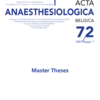Impact of opioid free Anesthesia versus opioid Anesthesia on post- operative oxygenation after bariatric surgery: an observational study
anesthesia; opioid; oxygen; bariatric surgery
Published online: Apr 21 2022
Abstract
Introduction: Opioid induced respiratory depression (OIRD) is a preventable etiology of post-operative respiratory depression with 85% of the episodes taking place in the first 24 postoperative hours. Due to altered respiratory functional metrics and frequently coexisting comorbidities, obese patients are at a particularly higher risk for such complications. The present study aimed to assess if an opioid- free anesthesia (OFA) was associated with postoperative respiratory depression when compared to Opioid-based anesthesia (OA).
Methods: Obese patients presenting for bariatric surgery were consecutively included in a non-randomized fashion. Lung protective ventilation strategies were applied in both groups. In the OA group, Sufentanil was used for intraoperative analgesia in a liberal fashion. In the OFA group, patients received a pre-induction dexmedetomidine loading, followed by a lidocaine, ketamine and dexmedetomidine bolus immediately before induction, further maintained throughout the intraoperative period. Plethysmographic saturations were obtained before induction as well as after extubation and in the post-anesthesia care unit (PACU). Opioid requirement and postoperative nausea and vomiting (PONV) incidence were similarly registered.
Results: Thirty-four patients were included in the OFA group, and 30 in the OA group. No significant anthropometric and comorbidity differences were found between both groups. OFA patients had significantly lower pre-induction saturations after dexmedetomidine loading. No difference was found for post-extubation saturations as well as well as pre-PACU discharge. The need for supplemental oxygen at the PACU was higher in the OA group. Opioid requirement and cumulative consumption were significantly higher with OA.
Conclusion: OFA was not associated with significant post-operative saturation changes. OA lead to higher need of postoperative oxygen therapy and more opioid rescue. No fatal respiratory complications were registered in both groups in the immediate postoperative period.
